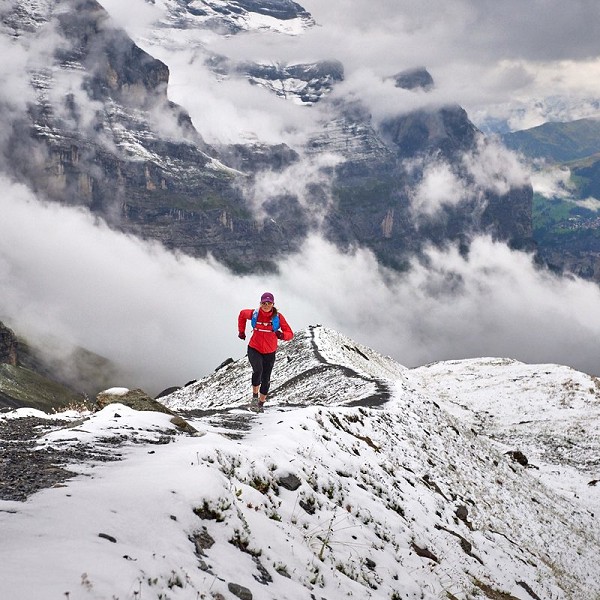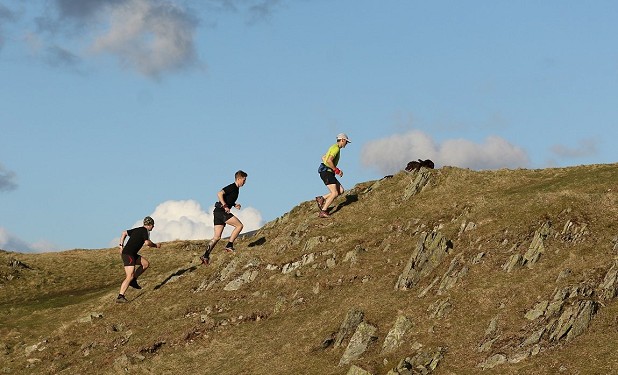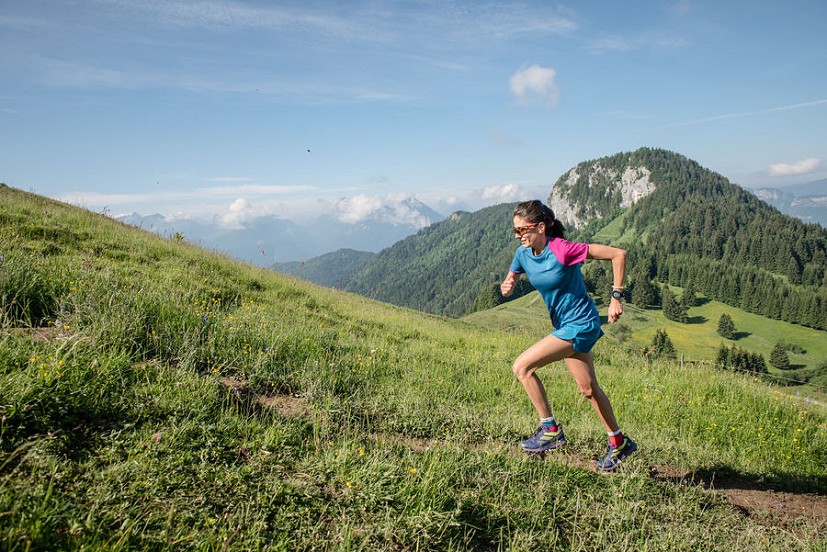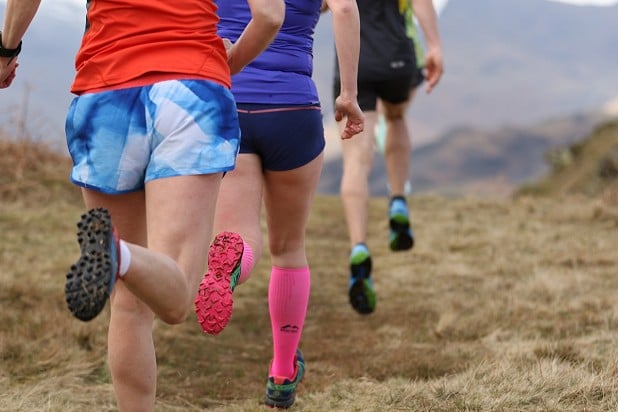15 Tips for Stronger Uphills
Trail running guru Claire Maxted offers advice on how to make ascents more efficient and less painful. And here's the thing: most of these tips work for walkers too!
Get your uphill technique right and you'll become a faster runner - or indeed a faster walker - with no extra training whatsoever. With subtle adjustments in both mind and body, you can become the master of running uphill and banish any dread you might have become used to feeling when you see a mountain climb looming. Like the sound of that? Here are some of the best tips on form, style and strategy from top off-road runners.
If you keep looking down at your feet you are hunched over and can't open up your lungs as much, which means less oxygen to your legs, making the hill even harder...
1 Take shorter steps
It's time to make your own imaginary staircase - don't make it too hard for yourself! "Shorten your strides and lean into the hill," says Mary Wilkinson, former international runner and sports scientist. "However, keep the same rhythm and effort as you would do when running on the flat. Taking smaller steps will keep you driving up and forward rather than over-striding and having to lift your weight over your foot. It feels like you are running faster and stronger with the higher cadence that comes from a shorter stride."
2 And more of them!
You've got your shorter steps dialled, now it's time to take more of them. Team Salomon athlete Emma Clayton says, "As well as taking short steps, keep your cadence high, drive with your arms and lift up your knees." If likening uphill running to another sport can help you visualise this frequent footfall, you'll find her teammate Stian Angermund-Vik's analogy useful, "Have a short cadence like you see in bike riders - they have a very low gear when they go uphill," he says.
3 Lean a little, but…
You'll naturally lean into a hill as you climb, but it's important to lean from the right place says Hoka athlete Sage Canaday from the USA. "Lean forward from your ankles, not from the waist," he says, "you don't want to hunch over as you want to keep your diaphragm open. So you're leaning forward from your ankles and then you want to get more up on your toes, focusing on a toe strike and the drive backward." Salomon athlete Max King agrees, "You are able to utilise your glutes a lot better if you keep a flat back and stay up nice and tall. Your muscle mechanics are much better if you can do this."
4 Don't look down!
You might have watched a fell race before and you can see who's finding the hill super tough as they plod up, head focussed on their feet. Mary advises otherwise for very similar reasons to the previous tip: "Keeping your head up will help you maintain good posture with a straight back. If you keep looking down at your feet it means you are prone to hunching over and can't open up your lungs as much, which means less oxygen to your legs, making the hill even harder." Don't make things harder for yourself than they already are!
5 Look up, but not too far
So looking down is out, but so is looking right at the top of the climb! Emma says, "When I've got a long tough session I focus on one spot on the ascent 5 metres in front. I'll rarely look up at what's left of the climb and try not to think about how much it's hurting, that's hard sometimes. I'll either start thinking of something else completely or keep visualising the end goal I'm working towards."
6 Harness arm power
You might think it's your legs doing all the hard work, but your arms can help you uphill too. Max says, "Use your arms to really get that stride going". Sage agrees: "Swing your arms a little bit more forcefully to get more power, really focus on that arm swing."
7 Run to your own beat
Rather than haring off up a hill then running out of gas half way up, Mary has this advice so you don't run out of steam. "Especially on long hills with constant gradients," she says, "try to find and then stick to a good running rhythm. I often find myself counting to my foot strikes, which keeps me focused and working at a constant effort." Yes, running more slowly uphill is a true trick of the trade. "Trying to get a hill over with quickly may result in it taking longer," says Emma. "It's better to run the hills at your own pace and not race those around you, which is easier said than done. Always feel like you're running within yourself on the early stages of an uphill so that effort doesn't come back to bite you later on."
8 Breathe better
It sounds obvious, but this is a tough one to master. Once you can handle it, breathing right will really boost your upward power. "Try to keep your breathing as relaxed as possible," says Sage. "It's always hard when you're running uphill no matter who you are, no matter what altitude or how steep it is; just realise that it's a challenge and embrace that challenge mentally. Try to keep your breathing under control, if you're hyperventilating in a long race you don't want to be doing that so that's when you might want to get into a power hike or strong-paced walk as that's going to be more efficient for you."
10 Power-hike!
It's not walking, it's power-hiking! Max and Sage both agree that walking fast up a steep hill is often more efficient and quicker than continuing to run, but how do you do it, and when do you engage this alternative gear? "If it's really really steep, get your hands on your knees and take small steps, kind of like a stair climber," says Max. "This will get you up the hill as quickly and efficiently as possible. Still keep your rhythm consistent and maintain a sustainable pace".
"Listen to your breathing" Sage advises. "If you're hyperventilating then take a power hike to let your body have a rest and get your breathing back under control before you start running again. It's walking with a purpose, marching up the hill."
All the pros power hike because it really works: "I've actually seen people moving faster using this method than some people running during tough parts of races," says Emma. "Power-walking really steep or technical sections can be more efficient."
11 Consider poles?
You could write a whole article on pole technique, and they're not allowed in some Scottish races and fell races, but on certain types of terrain and gradients, poles can really help. "Poles can really power you uphill, especially in steeper, technical terrain where you're trying to keep your balance a little bit better," says Max. "Practice with them first though! Don't use them in a race straight away because it takes some technique too to get smooth and efficient with them." They're also good on longer races, and for powering you along wide, even sections of trail, easing the impact on your joints and opening up your lung capacity.
12 Get in the zone
Missing your warm up can mess up your technique and even result in injury, so Emma advises, "About 15 minutes before for an uphill race or session do a couple of short (10 seconds max) hill sprints to ensure your key leg muscles are firing. You've a lot less chance of pulling something and performing well if you warm up before training or racing. I've grown up warming up with dynamic stretches and drills that mimic the action of running. You start slowly with light movements like calf and hip mobilisations, then heel kicks and high knees, then gradually increase the pace to finish with strides (leaping). This loosens the joints and muscles, and gets your body and mind ready to have good hard session or race."
13 Re-think mental barriers
We often think of uphill running purely in terms of bodily technique, but there's a whole host of mental techniques that can also help. "Uphill running can pose as much of a psychological barrier as a physical one," says Mary, who is also a Dr. of Physchophysiology (the scientific study of the interaction between mind and body).
She advises: "Break long ascents into manageable sections that you can tick off in your head as you complete them." Mary represented Great Britain at mountain running for nine years, winning six medals, including three team golds, proving this technique works for top level races. "In one World Championship trial race it was held over an uphill-only course at Sedbergh," she says, "so I split it into five parts and then it felt much more manageable in my head."
14 Recce race routes
There's a lot to be gained in races by knowing the exact nature of the uphill sections before you come to them, so you have an idea of which techniques to employ when. Even if you can't get to the course itself to recce the route and all its hills, you can get a lot of information online from maps, previous runners who have written blogs and the race website itself. Mary says, "Run the route beforehand or look at the gradient profile to identify key points like where there is a really steep part or a fast, flat section. Then you can pace yourself accordingly throughout the race, both physically and mentally."
15 Get grippy shoes
Finally, there's one point that affects your uphill technique massively, especially on muddy British hills; your shoes! "Ensure your shoes have good grip," says Mary. You can have the best technique in the world, but as she says, "There is nothing worse than your foot slipping as you try and drive off." Why not treat yourself to a super grippy pair this Christmas!





